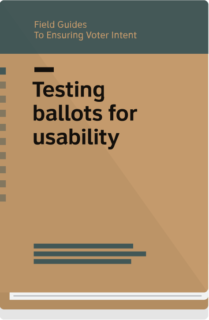Usability testing
Usability testing is a tool for learning where people interacting with a design – such as a ballot – encounter frustration, and translating what you see and hear to make a better design that will eliminate those frustrations.
At its essence, usability testing is a simple technique: Watch and listen to people who are like your voters as they use a design as they normally would. And then use those insights to improve your design.
It helps us:
- learn about our users
- observe where users struggle in a task
- learn what works and what doesn’t in our design
- make a better design that meets users’ needs
- make quick decisions
Testing can be done at many points in the design process including:
- Before you start redesigning something
- While you’re still working on a draft
- When a significant event happens that may cause changes or require staff or volunteers to be retrained
- When something about the voting situation has changed since the last election
When you conduct a usability test, you’re looking for both what worked (successes) and what didn’t work (failures).
For example:
- Any errors or mistakes – even if the participant corrects them
- Failure to complete or submit
- Places where the participant didn’t follow instructions
- Any signs that the participant doesn’t understand the information or actions needed
- Any errors specific to the material being tested
Getting started with usability testing
Testing ballots for usability
The top 10 guidelines for conducting usability tests of ballots come from two main sources. The first is a group…
Usability testing toolkit
5 variations of resources to help you run usability testing in different settings.
Conducting multilingual usability testing
This workbook will help you through the process of testing materials in multiple languages, and provide you with tools to run usability testing from pre-planning to reporting on what you learned.
Additional things to consider when usability testing
- Demystifying accessibility testing
- Testing ballots: Real names or fictional? Direct how to vote or not?
Examples of how CCD does usability testing
- A Voter Bill of Rights in plain language for California
- Breaking the ballot: 34 candidates for Senate
- Design, test, repeat: designing a new ballot record form
- Flash usability testing for double votes in New York
- Helping poll workers solve problems quickly with a What-If guide
- Initial observations and insights about ranked choice voting from a flash usability test
- Instructions on vote-by-mail ballots build confidence in Arapahoe County
- Listening to voters
- Participating in Participatory Budgeting
- What can you learn from usability testing in the civic space?




